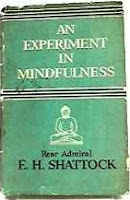
 |
| First I stretch, do my yoga asanas or poses, then I'm ready to relax. |
| Part of a series on |
| MINDFULNESS |
|---|
 |
| Category: Mindfulness |
Mindfulness-based stress reduction (MBSR) is a program that incorporates Buddhist mindfulness (sati) practice to assist people with pain and a range of conditions and life issues that were initially difficult to treat in a hospital setting.
Developed at the University of Massachusetts Medical Center in the 1970s by Prof. Jon Kabat-Zinn, MBSR uses a combination of mindfulness meditation, body awareness, and yoga to help people become more mindful.[1][2]
MBSR programs have been proposed for a wide variety of conditions including stress reduction.[3][4][5]
Clinical research studies have documented various physical and mental health benefits of mindfulness in different patient categories as well as in healthy adults and children.[2][6][7] While MBSR has its roots in spiritual teachings, the program itself is secular.[2][5][1]
History
 The concept of mindfulness has existed for over five millennia.[8][9][10] Many credit the Mindfulness Based Stress Reduction course for introducing mindfulness to mainstream Western culture.[11]
The concept of mindfulness has existed for over five millennia.[8][9][10] Many credit the Mindfulness Based Stress Reduction course for introducing mindfulness to mainstream Western culture.[11]
In 1979 Kabat-Zinn founded the Mindfulness Based Stress Reduction Clinic at the University of Massachusetts and nearly 20 years later the Center for Mindfulness in Medicine.[1]
Both of these institutions supported the successful growth and implementation of MBSR into hospitals worldwide.[1][2] Today close to 80% of medical schools offer some element of mindfulness training and research and education centers dedicated to mindfulness have proliferated.[12] More
The Buddha's Mindfulness Practice
Ven. Nyanatiloka (Buddhist Dictionary) edited by Wisdom Quarterly
The Four "Foundations of Mindfulness," literally "awareness of mindfulness" (sati-upatthāna), are the systematic contemplation of:
"The only [or the direct] way that leads to the attainment of purity, to the overcoming of sorrow and lamentation, to the end of pain and grief, to the entering of the right path, and to the realization of nirvana is the Four Foundations of Mindfulness."
After these introductory words and upon the question which these four are, it is said that the meditator dwells in contemplation of the body (the four elements), the feelings (sensations), the mind (four of the five khandhas), and the mind-objects "ardent, clearly conscious and mindful, after putting away greed and grief with regard to the world."
These four contemplations are in reality not separate exercises but, on the contrary, at least in many cases, especially in the meditative absorptions (jhanas), as things inseparably associated with each other.
Thereby the Satipathāna Sutra forms an illustration of the way in which these four contemplations relating to the Five Aggregates (khandha) simultaneously come to be realized, and finally lead to insight into the impersonality (not-self nature) of all existence.
(1) The contemplation of the body (kāyanupassanā) consists of the following exercises: More
The Buddha's Mindfulness Practice
Ven. Nyanatiloka (Buddhist Dictionary) edited by Wisdom Quarterly
The Four "Foundations of Mindfulness," literally "awareness of mindfulness" (sati-upatthāna), are the systematic contemplation of:
- body
- feeling
- mind
- mind-objects.
"The only [or the direct] way that leads to the attainment of purity, to the overcoming of sorrow and lamentation, to the end of pain and grief, to the entering of the right path, and to the realization of nirvana is the Four Foundations of Mindfulness."
After these introductory words and upon the question which these four are, it is said that the meditator dwells in contemplation of the body (the four elements), the feelings (sensations), the mind (four of the five khandhas), and the mind-objects "ardent, clearly conscious and mindful, after putting away greed and grief with regard to the world."
These four contemplations are in reality not separate exercises but, on the contrary, at least in many cases, especially in the meditative absorptions (jhanas), as things inseparably associated with each other.
Thereby the Satipathāna Sutra forms an illustration of the way in which these four contemplations relating to the Five Aggregates (khandha) simultaneously come to be realized, and finally lead to insight into the impersonality (not-self nature) of all existence.
(1) The contemplation of the body (kāyanupassanā) consists of the following exercises: More

































































































































































































































No comments:
Post a Comment